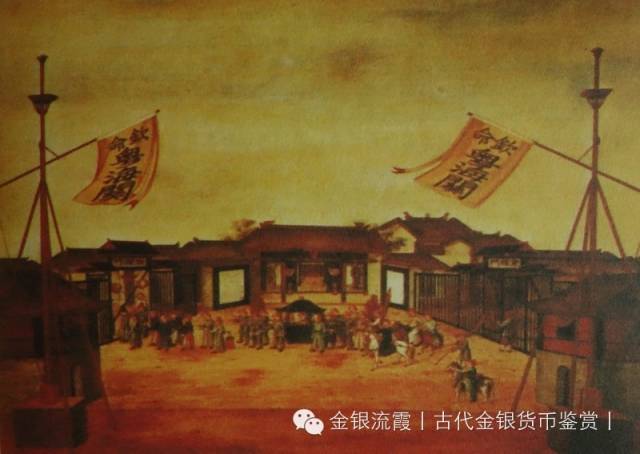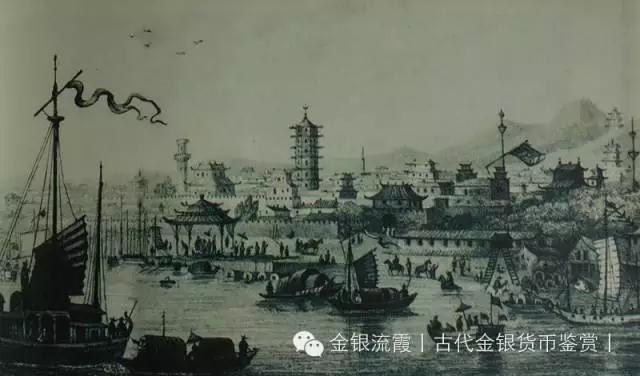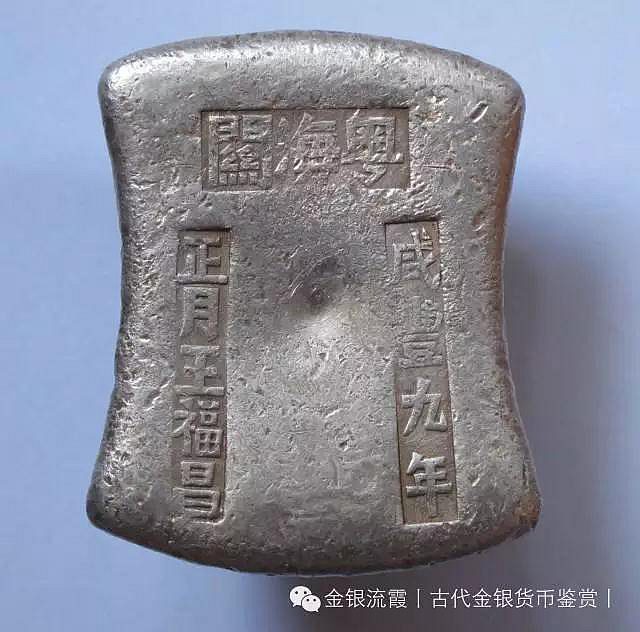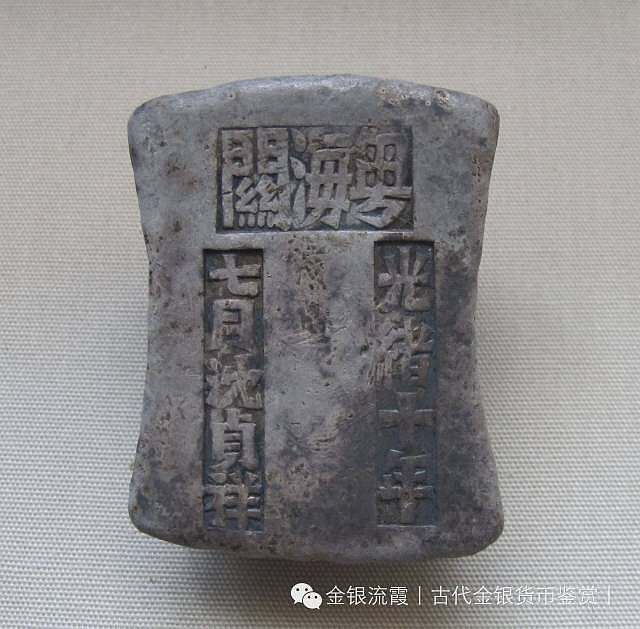李晓萍 英文王伟力 金银流霞丨古代金银货币鉴赏丨

岁月如梭,往事如烟,过去的一切都早已封存在人们的记忆之中。自清康熙23年(1684)起,随着海禁和粤海关的建立,来自于欧洲、美洲、亚洲等的大小商船日夜穿梭在珠江上,在带来了各种各样异国商品的同时,也带去了中国的生丝、茶叶、和瓷器。繁荣的进出口贸易给清政府带来了巨大的财富和利益,粤海关的关税成为清政府关税的收入的主要来源。第二次鸦片战争后,粤海关的对外征税部分改由英国人管理,关税直接支付战争赔款,粤海关成为名符其实的洋关。清代的关税是以白银来结算的,关税收入最终是以银锭的形式出现的。
然而,由于晚清的战争赔款、外国银元的通行和长期的熔熔铸铸等诸多原因,现存的粤海关银锭只有寥寥数十枚,理所应当地成为我们了解和研究粤海关的一个窗口。透过这个窗口,我们可以看到当年粤海关盛极一时的辉煌和繁盛。

粤海关的对外贸易税是由十三行行商负责征收的,行商还需要把征齐的白银熔铸成银锭上交关库。对国内贸易税则由粤海关监督派人征收,海关也要将收缴上来的散碎银两铸成银锭上交关库。而且,在征收白银的时候要加收耗银,以补熔铸银锭中的损失。曾有记载在澳门粤海关官署旁有一条银锭街,在此街上,可以自由买卖由各银炉铸造好的粤海关银锭。这也就是说,粤海关银锭是事先由银炉铸造好的,需要时只需购买使用。
和其他广东银锭一样,粤海关银锭也是采用砝码锭的造型,其锭面铭文排列很有规律,通常有上面一个戳记,左右各有一个戳记,像一个“门”字形,上横戳是“粤海关”;左边竖戳通常为纪年月;右边竖戳通常是银匠或银号名;也有部分粤海关银锭左右两戳都是纪年的。目前发现的粤海关银锭的银匠或银号名有郑兴隆、王福昌、陈合盛、高恒茂、五福、秦永合、沈德隆、沈贞祥、何泰丰等。纪年有嘉庆十年、道光十三年、二十八年、二十九年、三十年、咸丰元年、二年、三年、四年、六年、九年、十年、十一年、同治元年、同治五年、光绪五年、八年、九年等。

虽然清海关从康熙二十四年就开始征收关税,但是,目前发现最早的粤海关银锭是嘉庆十年,道光和咸丰年的相对多见,同治与光绪年的相对少见。这是因为清朝末年,随着对外贸易的进一步发展,外国银币以其大小划一、重量适中、便于交易等优点得到了历来受银两截割之劳的中国商民的广为欢迎,继而充斥于流通领域,尤其在广东、福建等沿海各通商口岸。这些外国银币重量为七钱二分,含银八一九成,实银只有六钱五分左右,在兑换中国的“足色纹银”时,都能兑换到八钱以上。这种不平等银两交易,使得中国的白银大量外流,给中国的财政造成不可弥补的损失。
光绪十三年(1887年)正月二十日,两广总督张之洞上奏朝廷,提出在广东设立钱局,用机器铸钱并制造银币:“广东华洋交错,通省皆用外洋银钱,波及广西,至于闽、台、浙江、皖、鄂、烟台、天津所有通商口岸以及湖南长沙、湘潭、四川打箭炉、前后藏无不通行,以致利归外洋,漏卮无底。窃惟铸币便民,乃国家自有之权利,铜钱银钱,理无二致,皆应我行我法,方为得体。……铸成之后,支放各种饷需官项,与征收厘捐、盐课、杂税及粤省洋关税项向收洋银者,均与洋银一同行用,不拘成数银色,另与外国上等洋银相等。粤省此次订购铸钱机器,兼有铸银圆机器,拟即选募西人善铸银元者来华试造”。尽管这一奏请被朝廷批复缓办,但张之洞并没有放弃制造银元的计划,他一方面请驻英公使刘瑞英与英国伯明罕喜敦造币厂(Ralph Heaton & Sons Mint)接恰订购全套造币机器设备,另一方面在广州东门外黄华塘买地82亩余,参照喜敦厂规模布局兴建新型造币厂。并一次又一次地恳请朝廷准许广东自制银元,终得朝廷“先由粤省行用”的准许。从此,银元成为广东的主要货币,致使银锭铸造逐步萎缩,最终退出流通领域。
粤海关银锭的魅力不仅在于它们的存世稀少,更重要的是,透过那些印刻在银锭上的铭文,让我们了解粤海关的发展历程、征税情况以及鸦片战争以后关税被用作战争赔款,从而使中国海关主权完全掌控在英国人手中的历史事实。
Foreign merchant ships from Europe,America,and Aisa came to Pearl River in Canton,Chinato trade with Chinese based on Canton system witch under direct control of Imperial court since 1684. The Canton System of trading brought huge benefits to the imperial court, taxes collected from custom revenue contributed most of the annual income during its heydays, more than any other source of income. As the result of Second Opium War, Convention of Peking states that one-fifth of the gross revenue from Canton Customs the recollected should be paid as war expenses quarterly. Taxes were paid with silver,witch would be casted into ingots. There are few silver ingots with marks of Canton Customs remained today due to various historical reasons; however the se examples could still be used as materials of researching with the Canton Systemof trading.
The Thirteen Factories were supervised by officials appointed by the imperial court to take charge and collect taxes for the goods traded, silver coins that collected earlier would be casted into ingots than handed later. Canton Customs collected taxes for national trading, and casting silver ingots. Extra units of silver would be collected in order to reduce losses during cast.Records shown that there were private mints located near the custom stations in Macau offering silver ingots with Canton custom marks; this indicated that these silver ingots could be prepared immediately when payments were asked.

The sesilver ingots were stamped with 3 marks on the surface, with Canton customsmark on the top, year of issuing mark on the left, and marks of name of mints or Jewelers on the right, some examples were stamped without names.Examples with various names have been found,dating back from 1805 to 1883.
Althoughthe custom stations were opened in 1685, the earliest example founded dated back in 1805,with more examples from later decade until 1870s. Silver coins suchas Spanish dollars and Mexican pesos were spread in China during 19thcentury, since silver was the only foreign commodity China would accept. In the late half of the 19th Century Western nations trading with China found it cheaper and more expedient to mint their own coins, from their own supplies of silver, than to continue to use coins from Mexican or Spanish piece of 8 reals.
The Viceroy of Liangguang,Zhang Zhidong, submitted a request producing silver coins at Canton mint in early 1887. The request was delayed by imperial court, however the plan continued with equipments and materials supplied by Ralph Heaton & Sons Mint, a brand new mint opened later and new coins were struck as the request was approved by imperial court, replacing nowout-dated copper cash and various silver ingots.
Silver ingots are crucial materials for research and analyses of Canton System, with evidences and proofs of how the unique trading control system works, its rise and fall, and impacts and legacies remained today.
( By Weili Wang)
©2024 yindingbowuguan.com
 |
 |
 |
 |
| 手机移动端 | 微信公众号 | 银博鉴定 | 商务合作 |